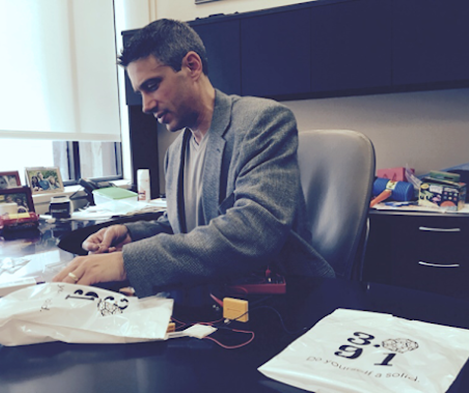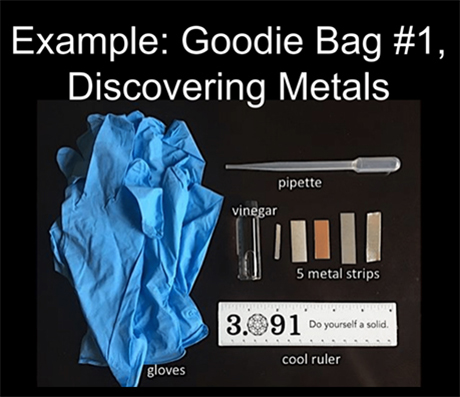In this section, Prof. Jeffrey Grossman discusses what inspired him to create “goodie bags” for the students in 3.091 Introduction to Solid-State Chemistry.
From Birthday Favors to Hands-on Chemistry

Professor Grossman prepares goodie bags for students in his course. Image courtesy of Drew Fitzgerald.
Before I first taught 3.091, I taught a thermodynamics class, a smaller class with 30 or 40 students, where it was possible to do a demo and have students come up and interact with it. In a class with hundreds and hundreds of students, you can’t do that.
Yet I always feel that if you can touch and feel some aspect of what you’re learning, you learn it in a richer way. You learn it from a different angle. You see the problem a little bit differently. So I said, “Well, okay. Instead of having a demo with 400 people looking at it or not being able to see it, let’s give the students little kits they can work with around the concepts of the week. And let’s give them problems that they can do, as a hands-on component that enhances the learning we’re doing that week.” That was the idea.
At the time, my youngest daughter was six, and she had gone to something like three birthday parties in one weekend. Our hallway had a whole bunch of these goodie bags with things like candy and toys. And I was looking at those things, thinking, “Maybe we can use this to do something more. Maybe we could put chemistry in these bags.”
Iterating on the Idea
In the first year, I was so excited to just get things into my students’ hands. So we created a set of goodie bags, about one each week, that we gave out, saying, “If you want to explore, here are some materials to work with.” And there was a lot of interest in that until the first round of exams hit. Then, since there wasn’t an assignment associated with it, and it wasn’t part of our exams, it became less and less easy for students to fit in.
"If you can touch and feel some aspect of what you’re learning, you learn it in a richer way."
So a couple of years ago, with help from some of our TAs, I reimagined the goodie bags. A lot of the materials stayed the same, but some changed, and now each week in the quiz, one of the two problems is actually something students have to bring a part of the goodie bag into and hold in their hands to answer. That way, the hands-on component is actually really integrated with metrics of success with the quiz problem itself. And I think the impact that the goodie bags have on their learning is more consistent.
Exploring Unknown Materials from the First Day
In the very first lecture, I talk about how chemistry came to be, and what were the early goals of chemists. One of the things that they did is to take something like a rock and say, “Well, how do you break this down? What is this thing made of?” And so maybe they’d smash it. Maybe they’d light it on fire. Maybe they’d mix it with this, they’d mix it with that, and they’d see what happens. Through that came the discovery of the basic building blocks of matter. Now, it took a long time until we knew that those building blocks were atoms, and how to build Mendeleev’s periodic table. But even thousands of years ago, that was the goal.

Goodie Bag Number 1: Discovering Metals
I want to put my students back in the position of the first chemists, where they’ll be explorers of these unknown materials. So in the very first goodie bag, I give students five different strips of something. I don’t tell them what they are. I give them a ruler to measure the strips, and they can weigh them, and of course what they find is that they’re different densities. So they learn about that. We’ve learned about Avogadro’s number. So they can tell me how many atoms are in them, or guess. I also give them some vinegar. And I just suggest, “Maybe you want to see what happens when you pour vinegar on them.”
Then they also find that one of these strips reacts with vinegar. So they can think about what that means.
Empowering Students to Try Out their Own Ideas
Every week, I get emails from students with pictures of them doing something with that week’s goodie bag that I didn’t ask them to do. They’re using this as a way to explore. In the first week, for instance, I got a picture of students putting vinegar on parts of MIT, because they wanted to test the reactivity. The goodie bag is meant to compliment what I’m teaching by giving a way for students to touch, and hold, and interact with the chemistry, but it’s also meant to allow them to go beyond what we’re learning and to try out their own ideas.










